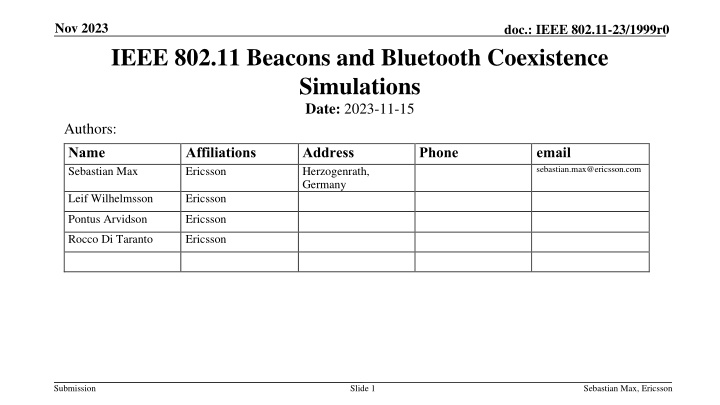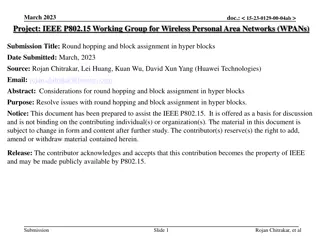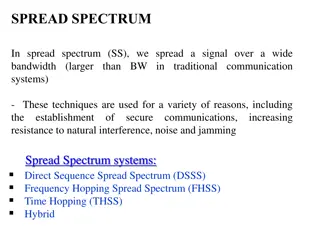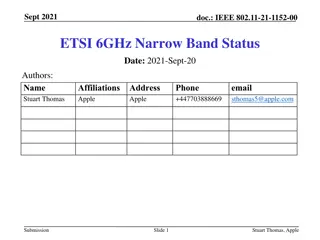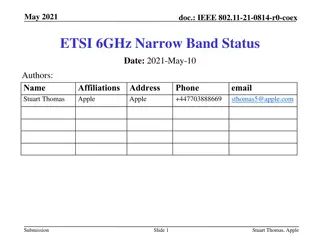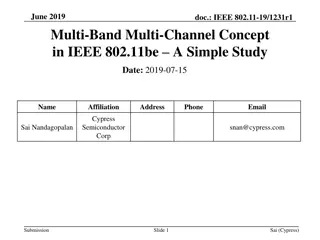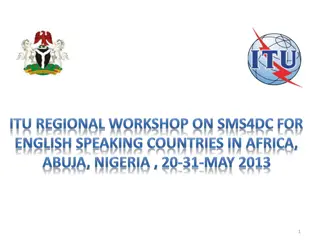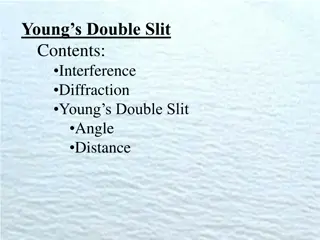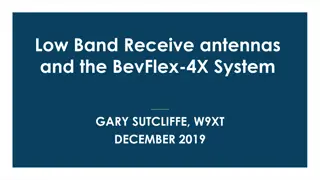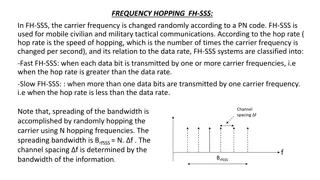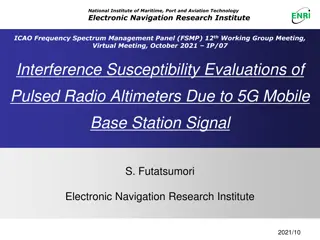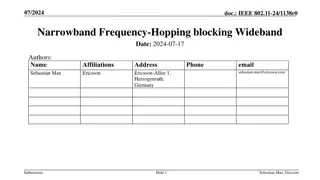IEEE 802.11-23/1999r0: Beacon Reception Impact of Narrow-Band Frequency Hopping Interference
Explore the impact of Narrow-Band Frequency Hopping (NBFH) interference on Wi-Fi beacon reception in IEEE 802.11-23/1999r0. The study delves into beacon traffic characteristics, spectrum usage assumptions, scenario analysis with Bluetooth links, and channelization details for Bluetooth ACL versus isochronous channels.
Download Presentation

Please find below an Image/Link to download the presentation.
The content on the website is provided AS IS for your information and personal use only. It may not be sold, licensed, or shared on other websites without obtaining consent from the author.If you encounter any issues during the download, it is possible that the publisher has removed the file from their server.
You are allowed to download the files provided on this website for personal or commercial use, subject to the condition that they are used lawfully. All files are the property of their respective owners.
The content on the website is provided AS IS for your information and personal use only. It may not be sold, licensed, or shared on other websites without obtaining consent from the author.
E N D
Presentation Transcript
Nov 2023 doc.: IEEE 802.11-23/1999r0 IEEE 802.11 Beacons and Bluetooth Coexistence Simulations Date: 2023-11-15 Authors: Name Sebastian Max Affiliations Ericsson Address Herzogenrath, Germany Phone email sebastian.max@ericsson.com Leif Wilhelmsson Ericsson Pontus Arvidson Ericsson Rocco Di Taranto Ericsson Submission Slide 1 Sebastian Max, Ericsson
Nov 2023 doc.: IEEE 802.11-23/1999r0 Introduction What is the impact of Narrow-Band Frequency Hopping (NBFH) interference on Wi-Fi s Beacon reception? Beacon traffic characteristics Every 102.4 ms, 450 s duration (duty cycle 0.44 %) Essentially not detectable by regular background scanning Broadcast, not ack ed No retransmission, no safety net Essential for Wi-Fi operation Network discovery & management, service discovery The following confirms & complements the results in doc. IEEE 802.11- 23/1622r0 [1] Submission Slide 2 Sebastian Max, Ericsson
Nov 2023 doc.: IEEE 802.11-23/1999r0 Assumption 1: Spectrum Usage / Channelization Bluetooth 1 MHz channels with 0.5 MHz guard band left & right Maximum 480 MHz 2 MHz = 240 channels Due to eDAA, hopping bandwidth is limited to Lowest 10 channels (~ 20 MHz) Lowest 20 channels (~ 40 MHz) Lowest 40 channels (~ 80 MHz) Lowest 76 channels (~160 MHz) Lowest 160 channels (~320 MHz) 236 channels (~ 480 MHz) Wi-Fi Transmit beacons on channel 1 (BSS 1) channel 33 (BSS 2) channel 65 (BSS 3) Submission Slide 3 Sebastian Max, Ericsson
Nov 2023 doc.: IEEE 802.11-23/1999r0 Assumption 2: Scenario Six Bluetooth links Constant bitrate traffic 320 B/20 ms ( 128 kb/s) 640 B/20 ms ( 256 kb/s) 1280 B/20 ms ( 512 kb/s) KPI: Packet delay 1, 2, or 3 Wi-Fi links 450 s Beacon every 102.4 ms ~3 s start delay KPI: Beacon success rate Channel model AWGN with Line-of-Sight for d < 5 m (pathloss coefficient 2.0), Non-Line-of-Sight for d > 5 m (3.5) Submission Slide 4 Sebastian Max, Ericsson
Nov 2023 doc.: IEEE 802.11-23/1999r0 Assumption 3: Bluetooth uses ACL (Async Connection-Oriented Link) 320B 320B 320 B payload every 20 ms: Two segments fit into one connection event Every other connection event remains idle ~16 % channel usage Seg 1 Seg 2 2.088ms 0.888ms Seg 1 Seg 2 t [ms] 10 20 0 1280 B payload every 20 ms: Five segments, require two connection events ~57 % channel usage Submission Slide 5 Sebastian Max, Ericsson
doc.: IEEE 802.11-23/1999r0 Bluetooth ACL versus Isochronous channels [1] 320B 320B Seg 1 Seg 2 2.088ms 0.888ms Seg 1 Seg 2 t [ms] 10 20 0 One channel per connection event, reply is sent on the same channel after T_IFS Separate channels for downlink and uplink(s) , 3 spectrum usage Submission Slide 6
Nov 2023 doc.: IEEE 802.11-23/1999r0 Coexistence mechanisms Submission Slide 7 Sebastian Max, Ericsson
Nov 2023 doc.: IEEE 802.11-23/1999r0 Bluetooth: LBT before Connection Event (CE-LBT) Sense current channel before every connection event Idle: transmit Busy: defer until next connection event Submission Slide 8 Sebastian Max, Ericsson
Nov 2023 doc.: IEEE 802.11-23/1999r0 Results Submission Slide 9 Sebastian Max, Ericsson
Nov 2023 doc.: IEEE 802.11-23/1999r0 Wi-Fi Beacon Success Rate 320 B/20 ms (16 % channel usage) 640 B/20 ms (30 % channel usage) 1280 B/20 ms (57 % channel usage) Impact proportional on amount of interference by NB links i. Beacon is interfered by later NB transmission ii. NB transmission starts, leaves gap of T_IFS=150 s which is sufficient to complete AC_VO backoff, Beacon is interfered by NB ack / 2nd segment. CE-LBT has no significant effect on beacon success rate due to (ii) CE-LBT and shorter T_IFS allow for spectrum sharing Submission Slide 10 Sebastian Max, Ericsson
Nov 2023 doc.: IEEE 802.11-23/1999r0 Wi-Fi Beacon Gap Sizes (No Coex) Probability of n missed beacons in a row 320 B/20 ms (16 % channel usage) 640 B/20 ms (30 % channel usage) 1280 B/20 ms (57 % channel usage) Hopping over 80 MHz reduces probability of more than 2 missed beacons close to zero Submission Slide 11 Sebastian Max, Ericsson
Sep 2023 doc.: IEEE 802.11-23/1999r0 Assumption 2B: Scenario B Decrease Bluetooth transmit power to 0 dBm Less signal strength at headsets Move Bluetooth links to the center between the Wi- Fi links More interference by the downlink-heavy Wi-Fi traffic 10 Bluetooth links Bluetooth links Wi-Fi link Wi-Fi link Wi-Fi link y [m] 5 0 8 -8 0 x [m] Submission Slide 12 Sebastian Max, Ericsson
Nov 2023 doc.: IEEE 802.11-23/1999r0 Wi-Fi Beacon Success Rate 320 B/20 ms (16 % channel usage) 640 B/20 ms (30 % channel usage) 1280 B/20 ms (57 % channel usage) Wi-Fi is no longer impacted by NBFH BPSK sufficient for reliable reception using the pessimistic Wi-Fi packet error rate model (see [2]) Submission Slide 13 Sebastian Max, Ericsson
Nov 2023 doc.: IEEE 802.11-23/1999r0 Conclusions Wi-Fi Beacon traffic interfered by NBFH allows good insights in coexistence Simple traffic model Simple KPIs Beacon reception rates might be impacted Passive scanning unlikely to detect beacons NBFH should use spectrum which is 99.5 % idle, but with coexistence mechanisms CE-LBT & short T_IFS LBT before every packet transmission (shown in [1]) ... but only one side of the coin NBFH is barely impacted under these assumptions Submission Slide 14 Sebastian Max, Ericsson
Nov 2023 doc.: IEEE 802.11-23/1999r0 References [1] NBFH coexistence with Wi-Fi, Menzo Wentink, Qualcomm, IEEE 802.11-23/1622r0 [2] IEEE 802.11 and Bluetooth Coexistence Simulations, Sebastian Max et al., Ericsson, IEEE 802.11-23/1477r1 Submission Slide 15 Sebastian Max, Ericsson
